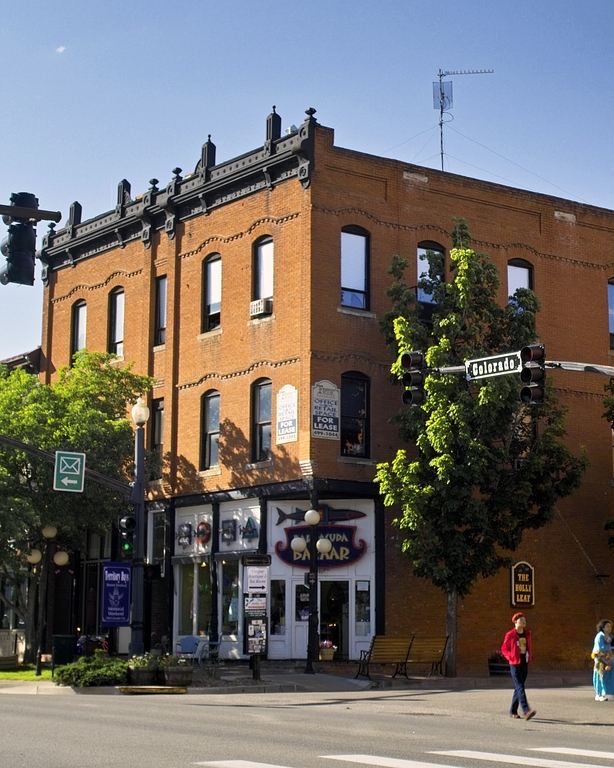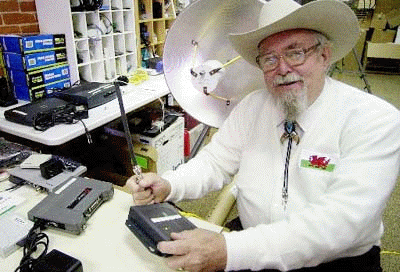Old Colorado City Communications In Several Roles
While Louis Jaffe and I started Old Colorado City Communications in 1978 originally to derive the bulk of its income from subscribers to its email, UUCP, and computer conferencing services, its functions and role changed over time.
Its location on the 2d floor of the Templeton Building, 2502 West Colorado Avenue never changed from the time it first opened until I finally closed it down in 2009 20 years later.
You can see in the photo below, the 20 foot high antenna mast on the roof, with one directional high gain (for 902 mhz frequency hopping signal ) antenna rod pointed through the Michael Garmen building, the trees in Bancroft Park, to the Historical Society attic antenna, serving the society's Web site and email half mile away and through many obstacles. The curved second antenna. with a 2.3 Ghz Wi-Fi signal pointed south a mile and a half to the roof of a company who used it for both general internet service and 24/7 security cameras, which the owner could access from home over his personal computer.
Also, out of sight, on the roof at the same time was a satellite internet dish antenna aimed at a satellite low in the southern sky with a radio receiver down in my office, that also fed, directly, the Internet. It was there for NSF experiments on the cost-effectivness of such a system that only used low orbiting satellites. Reliability, bandwidth, total and monthly cost. It was, as I expected, still too costly to use for anything that required a fast, or many, Internet connections - like graphics, video, voice over IP. Satellite internet was - and may still be - too costly except for needs in the most remote places where there is no ground based alternative. Several years after this photo was taken I was able to use a more cost-effective satellite service high on the slopes of Mount Everest.
I snaked the LMR copper cables from all the devices on the roof carrying the signals down two floors past unused chimneys, that originally served small wood or coal burning stoves in the many offices and apartments in that building in the 1890s, long before central heating was put in the historic building. (the Templeton building shown cost Henry Templeton $15,000 to build in 1891, was bought in 1976 when the westside was declared with slum and blight, for $75,000, and was resold after considerable upgrading, including electrical and telephone and ethernet wiring and the part of the Old Colorado City National Historic District in 1982, for $1.3 million in 2002. My office rent for Old Colorado City Communications went from $120 a month in 1976 when the Redevelopment of Old Colorado City was started to $650 a month by 2004 when the building was sold again.
 |
| OCC Offices were 2d floor, 4th window to the left |
* OCCC's business started out as a dial-up modem subscriber service that was only linked up nationally by UUCP protocol from our Unix System. At one time it handled 20 Robotics modems.
 |
| Old Colo City Comm Network Center in the Templeton Bldg |
* As soon as the TCP-IP protocols began to spread and larger cities and corporations such as Hewlett-Packard and US West put in servers for businesses, school systems, and government agencies, I contracted with US West to provide us a dedicated T-1 (1.5mbps) circuit the three miles to their offices and servers in downtown Colorado Springs. It would take 9 more years - to 2008 before Qwest was able to justify extending DSL - internet over telephone circuits - to Old Colorado City from downtown Colorado Springs 3 miles away.
* In 1980 I persuaded the national Internet authority (before even ARIN existed) to award us a 'Class -C' Internet Block of IP addresses. (A class C block is 255 unique IP addresses. And I registered it with a variation on our Company Name - Old Colorado City Communications - "oldcolo.com". Our numbers assigned then 192.160.122.0/24 or 192.160.122.0 through 192.160.122.255 were, and remain so long as I (or Old Colorado City Communications Company exists - which son David R Hughes will inherit) pays a $100 a year 'Legacy Fee to ARIN - The American Registry For Internet Numbers)
With that assignment which is one of the OLDEST (in the country) Class C licenses for an Internet set of IP's (Class C's are unobtainable now). That gave me the capability of having up to 254 devices - computers, servers, radios - each with a unique IP address. That became important in the 1990's when we offered the ONLY broadband Internet access to Old Colorado City Commercial District business via Wi-Fi and to 10 office-businesses in our building, by ethernet wire connection from their office into our officer where the server was. And that was because it took over 10 years from the time Downtown Colorado Springs had local commercial internet services from either US West (then Qwest) OR Comcast Cable before they 'reached' the OCC Commercial District with its over 75 small businesses. It cost me $450 a month for the T-1 from US West downtown to serve those wireless customers in Old Colorado City with full internet.
 |
| Old Colo City Com office when my Wireless business boomed. The window looks out over Colorado Avenue and the core 100 buildings of Old Colorado City are right below us. |
In fact, when I retired and closed down OCCC in 2010 and switched to bring a Business Class Comcast Internet service into my house both for its family television capability, and its Internet capability, ARIN awarded me their 'legacy' IP numbers - meaning I effectively 'own' those 255 unique IPv4 Block.
Then, from the beginning by giving ourselves and our subscribers their unique (from each other) email names starting with my address 'This email address is being protected from spambots. You need JavaScript enabled to view it.' we were fully connected to the Internet and could experiment, test, use all those IP addresses. And serve both individual and small business customers in the Old Colorado City Commercial District, (out to 2 miles range) from our building.
* From 1997 until 2010, 13 years I provided the ONLY Internet Service to the Old Colorado City Historical Society - wirelessly, through the equipment grant by the National Science Foundation in 1997. I offered that link pro-bono to the Society.
* After Louis Jafee left the business and Colorado Springs, Larry Fox - a well traveled businessman/entrepreneur, who ran, from his home, a International Supply business which did business in Africa, Latin America needed global telex, wire, communications became a 50% partner in Old Colorado City Communications. His international business experience, buying selling - increasingly higher tech things needed in small quantities in remote areas - import, export licenses, shipping methods and costs, supplemented my technical and telecommunications expertise made for a good partnership.
Increasingly I was contacted by small, and remote foreign enterprises. I was becoming known around the world for my electronic pioneering.
At one time when I was awarded an NSF Grant to provide and set up wireless Internet connectivity in Ulaan Bataar, Mongolia, Larry was able to ship quite a bundle of radios, cables, and antennas there by getting it into the US Diplomatic Pouch, bypassing Chinese customs, prying eyes, and fees. All got there on time for my sub-contractor, Dewayne Hendriks to arrive in Mongolia, get it from the Embassy, and install it all - which worked.
* Because accounting and bookkeeping became a burden, we took on my daughter Rebecca Hughes Clark and each of us, Larry and I, gave 10% of our share - giving her 20%, we each keeping 40% - her fees coming largely from the Administrative overhead of the NSF Grants over 7 years. She became the 'Institutional Representative' of OCCC to the NSF while I remained the Principal Investigator.
* When Larry Fox sickened and died from cancer, I bought out his share of OCCC from his widow, and then adjusted Rebecca's share. So that we went on until I closed down the business in 2009 with me having 60% and she 40%. The primary assets of the Company were at least $50,000 of technical equipment, some of which I sold. Like an original cost $20,000 spectrum analyzer, used, for $5,000. Rebecca was paid $2,000 - 40% I $3,000 - 60%. Storing the remainder.
* OCCC, with Marty Yazlowitz technically helping me out in exchange for some office space for his technical gear and internet connection through me, we served a number of clients, and became resellers of selected advanced radio equipment.
* That office space became a laboratory for much of our development. programming, and fabrication work for radios and devices we deployed in the field for scientists trying to get sensor data reliably from very remote places back to their premises.
One photograph of me in the OCCC office was widely distributed in various scientific publications. Even for established scientists and technical universities, I was in demand teaching them - sometimes in large conferences how to use advanced wireless to solve their perpetual problem of gathering field data efficiently and in a timely manner from very remote locations.

OCCC never really made a lot of money, But for seven years while we carried out a series of National Science Foundation projects, the $1.9 million in grant awards kept the doors open.
And my work with field scientists of all types whose experiments and research in remote places left a legacy of increasing reliance on advanced wireless connected to the Internet by those scientists and institutions, replacing the tedious historical manual methods of data collection and control used for hundreds of years before.
http://wireless.oldcolo.com/biology/progressreports.htm
The fact that a research scientist or his Phd doctoral candidate students could connect up from their universities or even from their homes in Colorado, to the temperature readings on a measuring device in a remote woods 30 miles north of Fairbanks Alaska, and even reprogram or change the settings on the device was an accomplishment I greatly contributed to between 1993 and 2000.
